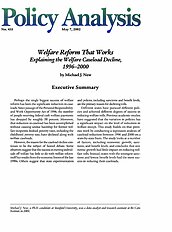Perhaps the single biggest success of welfare reform has been the significant reduction in caseloads. Since passage of the Personal Responsibility and Work Opportunity Act of 1996, the number of people receiving federal cash welfare payments has dropped by roughly 58 percent. Moreover, that reduction in caseload has been accomplished without causing undue hardship for former welfare recipients. Indeed, poverty rates, including the childhood poverty rate, have declined along with welfare caseloads.
However, the reason for the caseload decline continues to be the subject of heated debate. Some observers suggest that the success in moving individuals off welfare has little to do with welfare reform itself but results from the economic boom of the late 1990s. Others suggest that state experimentation and policies, including sanctions and benefit levels, are the primary reason for declining rolls.
Different states have pursued different policies and achieved different degrees of success in reducing welfare rolls. Previous academic studies have suggested that the variation in policies has a significant impact on the level of reduction in welfare receipt. This study builds on that previous work by conducting a regression analysis of caseload reduction between 1996 and 2000 on a state-by-state basis. The study looks at a number of factors, including economic growth, sanctions, and benefit levels, and concludes that economic growth had little impact on reducing welfare rolls. Instead, states with the strongest sanctions and lowest benefit levels had the most success in reducing their caseloads.

This work is licensed under a Creative Commons Attribution-NonCommercial-ShareAlike 4.0 International License.

